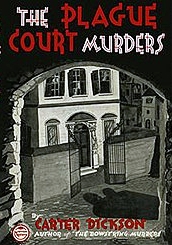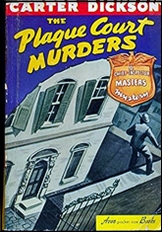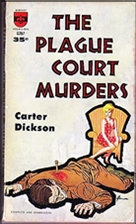Wed 6 Sep 2023
A 1001 Midnights Review: CARTER DICKSON – The Plague Court Murders.
Posted by Steve under 1001 Midnights , Reviews[3] Comments
by Robert E. Briney

CARTER DICKSON – The Plague Court Murders. Morrow, hardcover, 1934. Reprinted several times in paperback, including: Avon, 1941. Berkley G267, 1959. Belmont-Tower, 1974. IPL, 1990. American Mystery Classics, 2021.
The house in Plague Court had come into the hands of the Halliday family in 1833, having earlier been associated with the horrific figure of Louis Playge, a hangman’s assistant in the time of the Great Plague. For a hundred years, odd happenings, illnesses, suicides, and rumors of haunting had kept the house a white elephant that the family could neither use profitably nor get rid of.
Now a group of people is invited to spend the night in the house. The group includes Ken Blake, the book’s narrator; Inspector Masters of Scotland Yard; the current head of the Halliday family and his fiancee; and a psychical. researcher named Darworth, who has lately gained influence over two of the Halliday women.

The night is filled with unexplained incidents, but the climax comes when Masters breaks into the small stone house in the rear court and finds Darworth’s dead body. The door had been double-locked, from inside and from outside; there arc no other exits; and no one else is inside the house. Yet Darworth was stabbed with a dagger that once belonged to Louis Playge and was stolen the day before from a London museum.
Blake once worked for H. M. [Sir Henry Merrivale] in Military Intelligence, and Masters is a friend of both men. This connection draws H.M. into his first recorded case. He is memorably eccentric, but not yet the full-blown comic figure of the later books in the series. The atmosphere of Plague Court, in fact, is anything but light. An air of brooding and macabre menace is set up in the early pages and expertly maintained throughout. A second grisly murder occurs before H.M. finally traps a truly surprising “least likely” murderer.

Other H.M. cases include such ingenious locked-room murders as The Peacock Feather Murders (1937) and The Judas Window (1938), both justly regarded as classics of the form. A Graveyard to Let (1949) is set in New York and features another miraculous disappearance, in which a man dives into a swimming pool in full view of family and friends, and never reappears. The series comes to an end in a blaze of comic glory in The Cavalier’s Cup (1953), a substantial crime puzzle (although there is no murder) that reads like a combination of P. G. Wodehouse and Thorne Smith.
———
Reprinted with permission from 1001 Midnights, edited by Bill Pronzini & Marcia Muller and published by The Battered Silicon Dispatch Box, 2007. Copyright © 1986, 2007 by the Pronzini-Muller Family Trust.
September 7th, 2023 at 5:20 am
That must be the first time I’ve seen Cavalier’s Cup listed as one of the best Carter Dicksons!
September 7th, 2023 at 9:51 am
I don’t remember any of the details, but I read the book once and wondered afterward how it managed to get published. There is one by Christie toward the end of her career I felt the same way about, but for that one I’ve thankfully managed to forget the title.
September 7th, 2023 at 9:14 pm
Plotwise good Carr with fine atmosphere, but H.M. feels a little unformed, something soon corrected. One part of me wanted Carr to rewrite this with the more familiar H.M., but wisely he just wrote new ones.